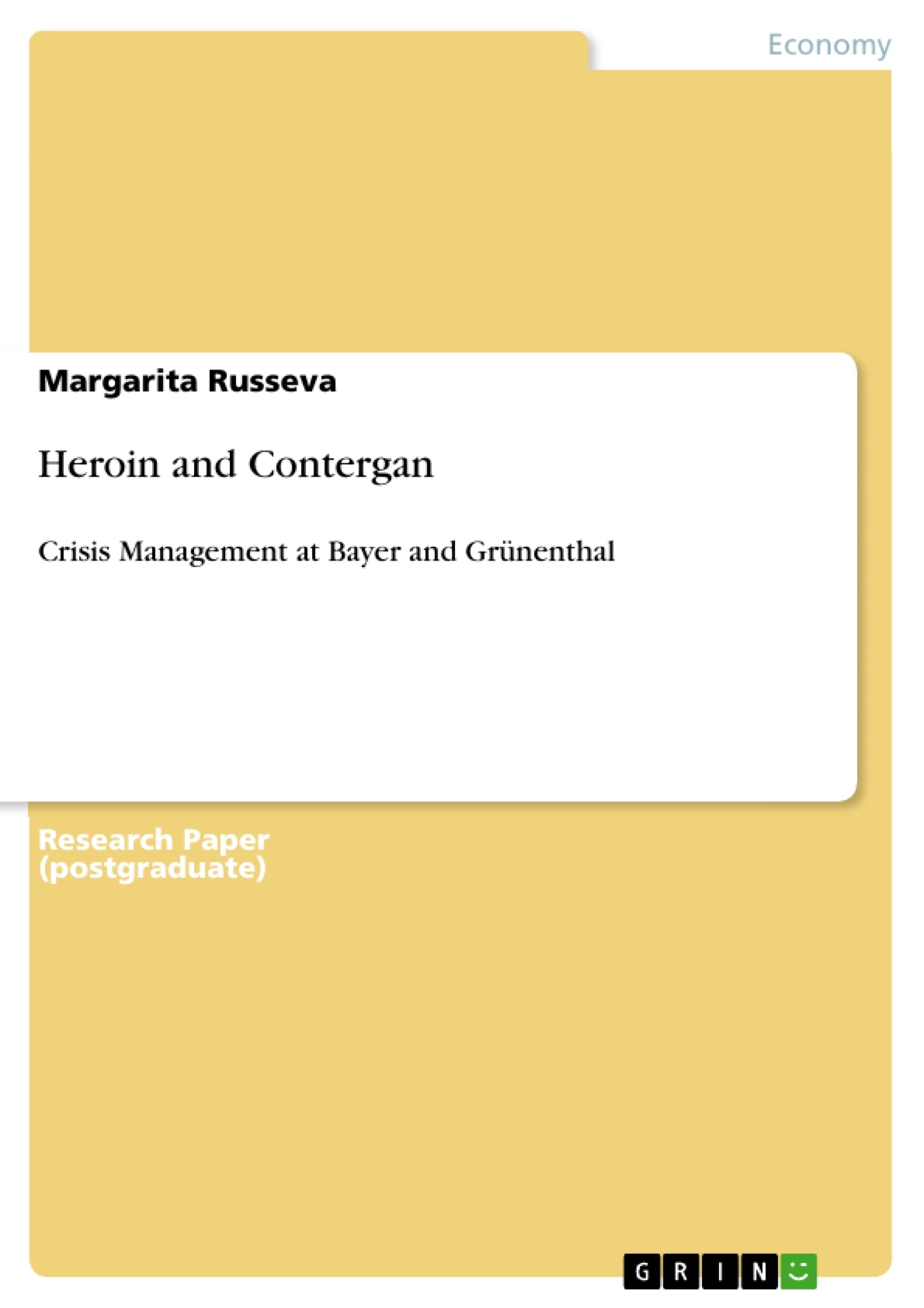In the modern medicine the use of pharmaceutical products for treatment of wide spectrum of diseases is indispensable and of common practice. Hence, the responsibility of the pharmaceutical companies to guarantee the safety of their drugs for human consumption is enormous. Unfortunately, there are cases from the history proving that due to improper testing and human negligence drugs caused more harm than good. Even in the present day, these tragedies are worth an examination in order to remember and learn from past mistakes and to prevent their recurrence. Many people believe that street drugs are “an entirely different class than prescription drugs, and they believe that pharmaceutical companies would never manufacture or sell street drugs”. Actually the well-known pharmaceutical giant, Bayer AG, is responsible for the most addictive and feared drug nowadays – heroin. Exactly 50 years ago, on 1. October 1957, another big pharmaceutical producer, Grünenthal, introduced the substance thalidomide. It was perscribed mainly as a sedative and for treatment of morning sickness during pregnancy, before it was discovered that the drug caused severe birth defects. In this assignment I will investigate the consequences caused by both drugs, as well the role of the producing company in the tragedy. By providing a brief history of the development of heroin and thalidomide, as well as a detailed research of the testing and marketing strategies, I am interested in the crisis management measures that Bayer AG and Chemie Grünenthal applied to handle the catastrophes. Since heroin and Contergan were distributed all over the world, their negative effects caused harm globally. In the conclusion of the assignment, I will give a short analysis of the corporation’s efforts to prevent further damage and to reverse existing problems, bearing in mind the social responsibilities of the pharmaceutical sector.
Table of Contents
- Introduction
- Crisis Management at pharmaceutical companies Bay
- Bayer and the Heroin Crisis
- Brief history of heroin, the new wonder drug
- Advertising and Marketing of Heroin
- Banning Heroin from the Market
- Bayer's Response to the Crisis
- Chemie Grünenthal and the Thalidomide Crisis
- Brief History of Grünenthal's thalidomide
- Research, development, testing and marketing of thalidomide
- The thalidomide tragedy
- Chemie Grunenthal's actions after the tragedy
- How victims were treated
- Conclusion
- References
Objectives and Key Themes
This assignment examines the consequences of two pharmaceutical tragedies caused by heroin and thalidomide, analyzing the role of the producing companies, Bayer AG and Chemie Grünenthal, in the events. Through a brief history of the development of both drugs, a detailed research of their testing and marketing strategies, and an investigation of the crisis management measures implemented by the companies, the assignment aims to shed light on the social responsibility of the pharmaceutical sector. It explores the companies' efforts to prevent further damage and reverse existing problems, considering the global impact of these drug crises.
- The history and development of heroin and thalidomide
- The role of Bayer AG and Chemie Grünenthal in the tragedies
- Testing and marketing strategies of both drugs
- The crisis management measures implemented by the companies
- The social responsibility of the pharmaceutical sector
Chapter Summaries
The introduction establishes the significance of pharmaceutical products in modern medicine, emphasizing the crucial responsibility of companies to ensure drug safety. It highlights historical examples of tragedies caused by drugs due to improper testing and negligence, underscoring the importance of learning from past mistakes.
The first chapter defines crisis management and explores its relevance to the pharmaceutical industry, highlighting the potential consequences of internal errors, such as insufficient research and improper testing, on the health of the population. It further emphasizes the need for pharmaceutical companies to be aware of their social responsibility.
The second chapter focuses on the heroin crisis, providing a brief history of the drug's development and outlining Bayer AG's role in its production. It details the initial advertising and marketing campaigns that positioned heroin as a safe and effective cure for various ailments.
The third chapter explores the thalidomide crisis, detailing the drug's history, research, development, testing, and marketing strategies. It delves into the tragic consequences of thalidomide's widespread use during pregnancy, leading to severe birth defects.
The fourth chapter examines Chemie Grünenthal's response to the thalidomide tragedy and the subsequent treatment of victims. It discusses the company's actions after the discovery of the drug's harmful effects and its efforts to mitigate the damage caused.
Keywords
The primary keywords and focus topics of this assignment include crisis management, pharmaceutical industry, social responsibility, heroin, thalidomide, Bayer AG, Chemie Grünenthal, drug development, testing, marketing, and public health.
- Quote paper
- Margarita Russeva (Author), 2007, Heroin and Contergan, Munich, GRIN Verlag, https://www.grin.com/document/117487



